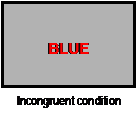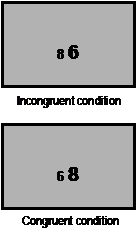Current Research Topics:
Attention
In everyday life there are constantly competing demands on attention by the outside world as well as from internally generated goals. The need for mechanisms to arbitrate between these competing demands is straightforward-so that they can be integrated, prioritized, or selected, to provide coherent and adaptive behavior. In our lab we study orienting of attention and selective attention. Orienting of visual attention to a point of interest may originate at will, as when we decide to look at a particular location where something of interest is expected, or it may originate reflexively without intention when something captures our attention, as when we orient to a flash of light in the dark or to a movement in the periphery of our vision. We study reflexive (exogenous) and controlled (endogenous) mechanisms of attention.

In order to study selective attention we create a conflict situation in which the subject has to respond to one stimulus or to one aspect of the stimulus and ignore another stimulus or another aspect of the stimulus. In these situations the subject needs to focus on the target (a stimulus or an aspect of a stimulus) and ignore all the rest of the display. The two most widely used paradigms for studying this type of selection are Stroop color naming and the flanker paradigm. In the Stroop task color-words are presented in color and subjects are asked to name the color of the ink and ignore the meaning of the word. People are commonly slower in responding to incongruent (BLUE in red) than to neutral (XXXX in red) or to congruent (RED in red) conditions. This suggests that they cannot ignore the meaning of the word (i.e., a failure of selective attention). In the flanker paradigm the relevant and irrelevant attributes are presented in separate locations, for example, when subjects must focus on a color patch at the center of a screen and ignore a flanking word.
Selected publications
- Berger, A., Henik, A., & Rafal, R. (2005). Competition between endogenous and exogenous orienting of visual attention. Journal of Experimental Psychology: General, 134, 207-221.

- Berger, A., Kofman, O., Livneh, U., & Henik, A. (2007). Multidisciplinary perspectives on attention and the development of self-regulation. Progress in Neurobiology, 82, 256-286.

- Goldfarb, L. & Henik, A. (2007). Evidence for task conflict in the Stroop effect. Journal of Experimental Psychology: Human Perception and Performance, 33, 1170-1176.

- Henik, A., Ro, T., Merrill, D., Rafal, R. & Safadi, Z. (1999). Interactions between color and word processing in a flanker task. Journal of Experimental Psychology: Human Perception and Performance, 25, 198-209.

- Lichtenstein-Vidne, L., Henik, A., & Safadi, Z. (2007). Task-relevance modulates the effects of peripheral distractors. The Quarterly Journal of Experimental Psychology, 60, 1216-1226.

- Okon-Singer, H., Tzelgov, J., & Henik, A. (2007). Distinguishing between automaticity and attention in the processing of emotionally-significant stimuli. Emotion, 7, 147-157.

- Sapir, A., Soroker, N., Berger, A., & Henik, A. (1999). Inhibition of return in spatial attention: Direct evidence for collicular generation. Nature Neuroscience, 2, 1053-1054.

Number Processing

We are interested in basic mental operations involved in numerical cognition. For example, we study processes involved in the association of symbols (e.g., digits, words) with quantities, and brain structures that underlie these processes. The picture that appears here (a small 8 trying to climb the ladder to the top of a big 3) represents the fact that digit symbols have their own physical features (e.g., physical size) that may modulate their effect. These physical sizes could be employed to ask questions about digit representation and usage. For example, in our culture 8 represents a larger value or size than 3, hence, the appearance of 8 as (physically) smaller than 3 might produce a conflict. Namely, 8 has a larger numerical value than 3 but in this picture it is physically smaller than 3. Psychologists have been using similar conflict situations to study automaticity and selective attention.

We use the comparative judgment paradigm in which a participant is presented with two numbers (e.g., 3 5) and asked to decide which one is numerically larger/smaller. This task gives rise to the distance effect-people respond faster when the two digits are further apart from one another (e.g., 3 8) than when they are close to one another (e.g., 6 8). It is possible to create a Stroop-like situation in which the digits differ not only in numerical value but also in physical size (e.g., 3 5). Commonly, people respond faster to congruent (e.g., digits that are both numerically and physically smaller / larger) than to incongruent pairs of digits-the size congruity effect. This suggests that people process the numerical values automatically (even when they are irrelevant to the task). In contrast, those with developmental dyscalculia show deficiencies in automatic processing of numerical values. Moreover, the size congruity effect involves the intraparietal sulcus (IPS) and deficiency presented by people with developmental dyscalculia might involve this area.
Selected publications
- Ashkenazi, S., Henik, A., Ifergane, G., & Shelef, I. (2008). Basic numerical processing in left intraparietal sulcus (IPS) acalculia. Cortex, 44, 439-448.

- Cohen Kadosh, R., Cohen Kadosh, K., Schuhmann, T., Kaas, A., Goebel, R., Henik, A., & Sack, A. T. (2007). Virtual dyscalculia induced by parietal lobe TMS impairs automatic magnitude processing. Current Biology, 17, 689-693.

- Cohen Kadosh, R., & Henik, A. (2006). A common representation for semantic and physical properties: A cognitive-anatomical approach. Experimental Psychology, 53, 87-94.

- Henik, A., & Tzelgov, J. (1982). Is three greater than five: The relation between physical and semantic size in comparison tasks. Memory & Cognition, 10, 389-395.

- Rubinsten, O., Henik, A., Berger, A., & Shahar-Shalev, S. (2002). The development of internal representations of magnitude and their association with Arabic numerals. Journal of Experimental Child Psychology, 81, 74-92.

- Rubinsten, O., & Henik, A. (2006). Double dissociation of functions in developmental dyslexia and dyscalculia. Journal of Educational Psychology, 98, 854-867.

Synesthesia

Synesthesia means blending of senses. That is, sensory experiences (e.g., sound, taste) or concepts (e.g., words, numbers, time) automatically evoke additional precepts (e.g., color). The majority of experimental work has focused on understanding the phenomenon in isolation. For example, research has attempted to reveal the mechanism(s) that underlies synesthesia or the stage(s) of processing on which the synesthetic experience depends. Independent of this line of research, however, the study of synesthesia may help to better understand the non-synesthetic mind. Understanding the phenomenon requires forays into fields such as perception, awareness, representation, development and neuroanatomy, and it therefore provides a good testing ground for many ideas and theories about different areas of cognitive science. Our research is aimed at unraveling the neurocognitive mechanisms of synesthesia and its implications for models of neurocognitive functioning. We study both grapheme-color and number-form synesthesia.
Selected publications
- Cohen-Kadosh, R., & Henik, A. (2007). Can synaesthesia research inform cognitive science? Trends in Cognitive Science, 11, 177-184.

- Cohen-Kadosh, R., Henik, A., Walsh, V. (2007). Small is bright and big is dark in synaesthesia. Current Biology, 17, 834-835.

Word Processing
Imagine that you are presented with a series of letters and asked to decide if this series is a word or a non-word. Various aspects of the presented stimulus and the experimental context affect performance. For example, concrete words (e.g., table) are processed faster than abstract (e.g., love) words, and responding to a word is facilitated if preceded by a semantically (or otherwise) related word (e.g., the word dog preceded by cat compared to dog preceded by chair)-the priming effect.

Psychologists have long suggested that our memory is organized as a network of concepts. In this network, associated or semantically related concepts are closer than non-associated or semantically unrelated concepts. This structure of the network gives rise to the priming effect. Within such a network one can examine various features of neighborhoods; how many neighbors a word has, how dense a given neighborhood is, etc. Aside from studying the automaticity of word processing, we have recently started investigating various features and effects of the semantic neighborhood and how individual differences in verbal abilities modulate these effects.
Selected publications
- Anaki, D., & Henik, A. (2003). Is there a "strength effect" in automatic semantic priming? Memory & Cognition, 31, 262-272.

- Henik, A., Friedrich, F. J. & Kellogg, W. A. (1983). The dependence of semantic relatedness effects upon prime processing. Memory & Cognition, 11, 366-373.

- Henik, A., Rubinsten, O., & Anaki, D. (Eds.). (2005). Word Norms in Hebrew. Ben-Gurion University of the Negev.
- Ron-Kaplan, I., & Henik, A. (2007). Verbal ability modulates the associative neighbors effect. Psychonomic Bulletin & Review, 14, 81-87.
